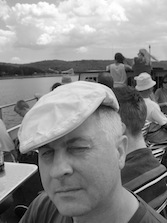


我的摄影生涯超过36年,可以总结为五个部分。
第一部分称为“一个身体一个灵魂”,是1984年 - 1990 年间的黑白照片,大多数为俯拍照片。通过人物的姿态、位置及构图俯拍出躺着的人物及物体,当时被称为“现场照片”。照片的透视感及重力感被破坏掉,因此人可以飞,可以在手上走路,可以在头顶上站30个人等等。 个别摄影照片被安排拍摄一些附带说明陈述的故事性题材的照片,比如我的童年回忆、我的梦想、青春期幻想,还有我最喜欢的斯洛伐克明见神话故事等等,我曾经抱着满腔热情去仔细阅读并在脑海中勾勒场景。
第二部分命名为回归自然,1992年-1998 年间拍摄的在暗房中使用两个放大机进行制作的蒙太奇照片。这些蒙太奇照片是将自然景观与拍摄的人或动物的肢体或细节部分联系在一起。例如,一座山可以看做是鲤鱼的身体、岩石可能是一个人的嘴,两条河流的交汇点可以是人的双腿等等。照片表达了人类与自然界的共存的关系,也阐述了人类只有选择与自然共生才能生存。
第三部分叫做启蒙及洞悉,是 1999年 - 2006 年的黑白照片拼贴画。女性裸体出现在照片中,有一些私密甚至是很私密的细节。这一阶段的许多照片,启蒙及洞悉穿越了其他照片所能看到的一些细节。有些照片带有情色色彩,所以以拼贴画的方式加密存储。观看者常常需要花费时间去理解什么是什么,哪里是哪里。
第四部分从2007年开始创作,尚未完成。我将它命名为大女人小男人。同样是蒙太奇照片,有黑白的,也有彩色的,不同的是这次是利用电脑进行的数码照片后期制作。男人女人一丝不挂的展现他们本身,我利用肢体进行构图创建出我想象世界中的男人和女人,而这种想象并不是基于对现实世界的观察或我的幻想。女性变得更强大,而男人总是试图去改变他们?
第五部分题为肖像。照片照片涵盖自1991年至今的一些照片,包括黑白、彩色、拼接及数码照片。在照片系列中,有几组人物肖像,例如企业雇员,学校学生等,照片被排列成一种视觉语言,通过之前四章中提到的制作手法完成。
所有阶段的照片都形成了一个系列或者循环,那些被命名为单独图片或系列的照片是一个相对的补充。在我的所有照片中,一条主线贯穿其中,它代表了我试图去寻找一种独一无二且明朗的摄影视觉语言所做出的所有努力,其中包括表达自我的一种目的,还有一种冒险去探知未知与未尝试过的摄影媒介的渴望。因此,伴随着我年龄、思维及世界观的变化,我的照片也发生着变化。当我在图片中可以认知自己的时候,它们就是完整和真实的。
Miro Švolík
于2011年捷克共和国布拉格
My photographic work over the past 36 years could be summarized in five chapters.
The first chapter is called "One Body One Soul. They are black and white analogue photographs from between 1984 - 1990. Mostly, they are photographs taken from above in the downward direction. Lying people and objects create, by their bodies and positions, compositions that can be called "live pictures". Both the perspective and the gravitation are disrupted. People can fly, walk on their hands, one man can hold another 30 people above his head, and the like. Individual photographs are arranged into stories in which, what is depicted with some overstatement, are the memories of my childhood, my imagination and dreaming of the period of my puberty and the world of the Slovak folk fairy tales which I loved very much, which I enthusiastically used to read and identify with in my mind.
The second chapter of the photographs is called Back to Nature. These black and white analogue photographs are from the years 1992 - 1998. They are photomontages created in the darkroom using two enlargers. These are photomontages of different parts, details of human and animal bodies associated with the landscape. For example, a mountain can be part of the body of a carp, rocks may be a mouth of a man, the confluence of two rivers may be human legs, etc. Photographs express the unity of a human being and the nature and the fact that people can exist only in symbiosis with the nature.
The third chapter is called Openings and HOLES. They are black and white photographic collages of the years 1999 - 2006. In the photographs, naked female bodies are displayed, their details, often intimate, sometimes very intimate. In many photographs of this chapter, openings and holes are cut through which details of other photographs can be seen. The photographs have a high degree of eroticism in them which is often encrypted in the form of a mechanical collage. The viewer sometimes understands only after a while what's what and where is where.
The fourth chapter (perhaps still unfinished) has been being processed since 2007. It's name is Big Woman Little Man. They are black and white and colour photographs, made digitally. Again, they are montages but they are made using a computer. Men and women are displayed in them, dressed only in their birthday suits. The compositions of their bodies create the world of men and women in my imagination. This imagination is either based on my observation of the real world or on my fantasy. The woman is stronger, bigger; the man is constantly trying to change something about them?
The fifth chapter is entitled Group Portraits. The photographs have been being created since 1991 to the present (2010). They are black and white, colour, analogue and digital. In the photographs, there are groups of people, e.g. employees of companies, school students, etc. The photographs are made using a visual language, generated by methods that are discovered and found in the previous four chapters.
The photographs in all chapters are arranged mostly in larger series or cycles. Names of individual photographs or series are complementary to the meaning and sense of their existence. Through the whole body of my work, an imaginary thread meanders which represents my own effort to find a unique and unmistakable visual language in photography. This involves an endeavour to express myself and a desire for adventure in discovering the unknown and not yet tried in the medium of photography. What is achieved and created is not the goal but the way of seeking and finding. So, as my life, my age, my thinking, my world view change, so do my photographs develop and change as well. Photographs are completed and truthful when I recognize myself in them.
Miro Švolík
In Prague, Czech Republic, 2011